Fault Cycling and Its Impact on Hydrocarbon Accumulation: Insights from the Neogene Southwestern Qaidam Basin
Abstract
1. Introduction
2. Research Object and Methodology
2.1. Research Object
2.1.1. Location, Stratigraphy, and Tectonic Settings
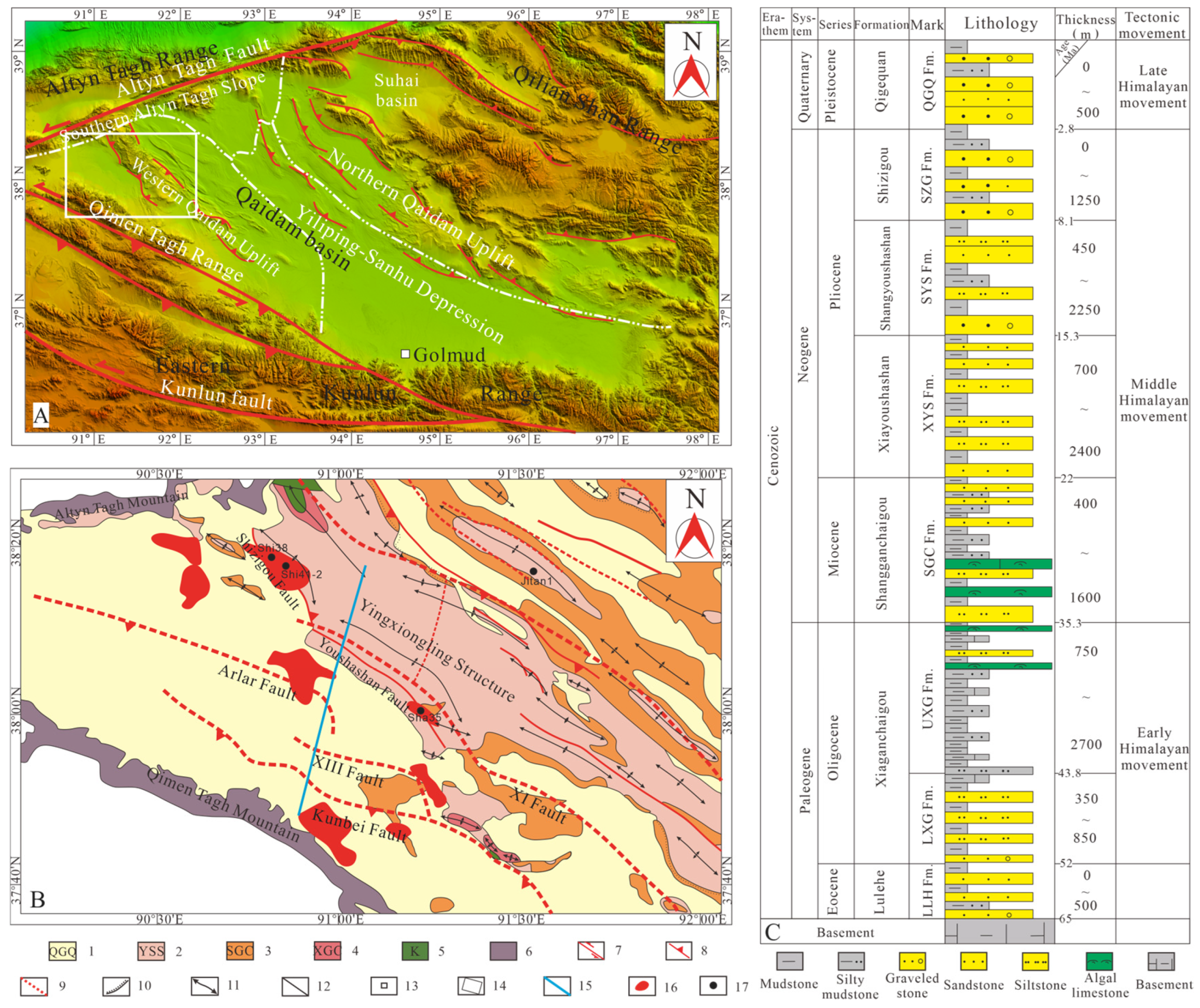
2.1.2. Characteristics of Petroleum Geology and Geochemistry
2.2. Methodology
2.2.1. Data
2.2.2. Fault Activity Analysis Method
2.2.3. Fault Cycle Division
3. Results
3.1. Characteristics of Fault Development
3.2. Analysis of Fault Activity
3.3. Division of Fault Cycles
4. Discussion
4.1. Tectonic Control of Fault Cycle in Southwest Qaidam Basin
4.2. Relationship Between Fault Cycle Models and Hydrocarbon Accumulation
4.2.1. Early Fault Cycle Controls Basin Formation and the Development of Early Traps
4.2.2. Mid Fault Cycle Controls the Formation and Distribution of High-Quality Source Rocks
4.2.3. Late Fault Cycle Controls Trap Finalization and Oil–Gas Migration
5. Conclusions
- (1)
- Influenced by multi-phase tectonic movements, fault activity in the southwestern Qaidam basin exhibits periodic characteristics, with three distinct periods of intense activity occurring during the LLH Fm., the UXG Fm., and the SZG Fm.
- (2)
- Based on the structural evolution history and fault activity characteristics of the southwestern Qaidam basin, a fault cycle model for this region is established. Fault activity in the southwestern Qaidam basin can be classified into three fault cycle types: early-middle, early-middle-late, and late fault cycles.
- (3)
- The proposed fault-cycle-controlled hydrocarbon accumulation model demonstrates that the dynamic evolution of fault cycles exerts multi-phase control on hydrocarbon accumulation. The early fault cycle primarily controls the basin’s initial morphology and the formation of early traps. The middle fault cycle is crucial for the distribution of high-quality source rocks, while the late fault cycle determines the final configuration of traps and hydrocarbon migration.
Author Contributions
Funding
Data Availability Statement
Conflicts of Interest
References
- Suess, E. Das Antlitz der Erde; F. Tempsky: Vienna, Austria, 1909; Volume 2. [Google Scholar]
- Wilson, J.T. A New Class of Faults and their Bearing on Continental Drift. Nature 1965, 207, 343–347. [Google Scholar] [CrossRef]
- Chen, S.P.; Wang, Y.; Jin, Z.J. Controls of tectonics on both sedimentary sequences and petroleum systems in Tarim Basin, northwest China. Pet. Sci. 2007, 4, 1–9. [Google Scholar] [CrossRef]
- Liu, S.X.; Zhang, G.C.; Zhao, Z.G.; Xie, X.X.; Wang, L.; Song, S.; Guo, J.; Wang, S.L.; Bi, Y.K.; Wang, Y.B. Control of tectonic cycle in South China Sea over hydrocarbon accumulation in the Zengmu Basin. China Pet. Explor. 2016, 21, 37. [Google Scholar]
- Fadul, M.F.; El Dawi, M.G.; Abdel-Fattah, M.I. Seismic interpretation and tectonic regime of Sudanese Rift System: Implications for hydrocarbon exploration in Neem field (Muglad Basin). J. Pet. Sci. Eng. 2020, 191, 107223. [Google Scholar] [CrossRef]
- Belayouni, H.; Guerrera, F.; Martín-Martín, M.; Tramontana, M.; Bullejos, M. Cenozoic tectono-sedimentary evolution of the onshore-offshore Tunisian Tell: Implications for oil-gas research. Mar. Pet. Geol. 2023, 156, 106426. [Google Scholar] [CrossRef]
- Manzocchi, T.; Ringrose, P.S.; Underhill, J.R. Flow through fault systems in high-porosity sandstones. Geol. Soc. Lond. Spec. Publ. 1998, 127, 65–82. [Google Scholar] [CrossRef]
- Zeng, J.H.; Jin, Z.J. Experimental investigation of episodic oil migration along fault systems. J. Geochem. Explor. 2003, 78–79, 493–498. [Google Scholar] [CrossRef]
- Wang, Z.Y.; Gao, Z.Q.; Fan, T.L.; Zhang, H.H.; Yuan, Y.X.; Wei, D.; Qi, L.X.; Yun, L.; Karubandika, G.M. Architecture of strike-slip fault zones in the central Tarim Basin and implications for their control on petroleum systems. J. Pet. Sci. Eng. 2022, 213, 110432. [Google Scholar] [CrossRef]
- Liu, L.; Sun, Y.H.; Chen, C.; Lou, R.; Wang, Q. Fault reactivation in No.4 structural zone and its control on oil and gas accumulation in Nanpu sag, Bohai Bay Basin, China. Pet. Explor. Dev. 2022, 49, 824–836. [Google Scholar] [CrossRef]
- Liu, Y.T.; Dai, S.H.; Zhou, Y.J.; Ding, F.F.; Li, M.J.; Li, X.Y.; Zhao, Y.; Guo, B.H.; Li, T.; Han, J.N. Fault characteristics and their control on oil and gas accumulation in the southwestern Ordos Basin. Energy Geosci. 2024, 5, 100151. [Google Scholar] [CrossRef]
- Jessop, K.; Daczko, N.R.; Piazolo, S. Tectonic cycles of the New England Orogen, eastern Australia: A Review. Aust. J. Earth Sci. 2019, 66, 459–496. [Google Scholar] [CrossRef]
- Song, T.G.; Wang, X.P. Structural Styles and Stratigraphic Patterns of Syndepositional Faults in a Contractional Setting: Examples from Quaidam Basin, Northwestern China. AAPG Bull. 1993, 77, 102–117. [Google Scholar] [CrossRef]
- Yin, A.; Dang, Y.Q.; Zhang, M.; McRivette, M.W.; Burgess, W.P.; Chen, X.H. Cenozoic tectonic evolution of Qaidam basin and its surrounding regions (part 2): Wedge tectonics in southern Qaidam basin and the Eastern Kunlun Range. In Special Paper 433: Whence the Mountains? Inquiries into the Evolution of Orogenic Systems: A Volume in Honor of Raymond A. Price; Geological Society of America: Boulder, CO, USA, 2007; pp. 369–390. [Google Scholar] [CrossRef]
- Yin, A.; Dang, Y.Q.; Wang, L.C.; Jiang, W.M.; Zhou, S.P.; Chen, X.H.; Gehrels, G.E.; McRivette, M.W. Cenozoic tectonic evolution of Qaidam basin and its surrounding regions (Part 1): The southern Qilian Shan-Nan Shan thrust belt and northern Qaidam basin. Geol. Soc. Am. Bull. 2008, 120, 813–846. [Google Scholar] [CrossRef]
- Yin, A.; Dang, Y.Q.; Zhang, M.; Chen, X.H.; McRivette, M.W. Cenozoic tectonic evolution of the Qaidam basin and its surrounding regions (part 3): Structural geology, sedimentation, and regional tectonic reconstruction. Geol. Soc. Am. Bull. 2008, 120, 847–876. [Google Scholar] [CrossRef]
- Meng, Q.R.; Fang, X. Cenozoic tectonic development of the Qaidam Basin in the northeastern Tibetan Plateau. In Investigations into the Tectonics of the Tibetan Plateau; Geological Society of America: Boulder, CO, USA, 2008. [Google Scholar] [CrossRef]
- Zeng, L.B.; Tang, X.M.; Qi, J.F.; Gong, L.; Yu, F.S.; Wang, T.C. Insight into the Cenozoic tectonic evolution of the Qaidam Basin, Northwest China from fracture information. Int. J. Earth Sci. 2012, 101, 2183–2191. [Google Scholar] [CrossRef]
- Wu, L.; Xiao, A.C.; Ma, D.D.; Li, H.G.; Xu, B.; Shen, Y.; Mao, L.G. Cenozoic fault systems in southwest Qaidam Basin, northeastern Tibetan Plateau: Geometry, temporal development, and significance for hydrocarbon accumulation. AAPG Bull. 2014, 98, 1213–1234. [Google Scholar] [CrossRef]
- Cheng, X.; Zhang, D.W.; Jolivet, M.; Yu, X.J.; Du, W.; Liu, R.C.; Guo, Z.J. Cenozoic structural inversion from transtension to transpression in Yingxiong Range, western Qaidam Basin: New insights into strike-slip superimposition controlled by Altyn Tagh and Eastern Kunlun Faults. Tectonophysics 2018, 723, 229–241. [Google Scholar] [CrossRef]
- Li, J.; Zeng, L.B.; Li, W.L.; Zhang, Y.S.; Cai, Z.H. Controls of the Himalayan deformation on hydrocarbon accumulation in the western Qaidam Basin, Northwest China. J. Asian Earth Sci. 2019, 174, 294–310. [Google Scholar] [CrossRef]
- Liu, G.Y.; Wu, S.T.; Wu, K.Y.; Shen, Y.; Lei, G.; Zhang, B.; Xing, H.T.; Zhang, Q.H.; Li, G.X. Characteristics and hydrocarbon accumulation model of Paleogene whole petroleum system in western depression of Qaidam Basin, NW China. Pet. Explor. Dev. 2024, 51, 1097–1108. [Google Scholar] [CrossRef]
- Wang, Y.Q.; Liu, Z.G.; Song, G.Y.; Zhu, C.; Li, S.M.; Wu, Y.X.; Xia, Z.Y.; Shi, Q.; Jia, S.L. Development, sand control mechanism and hydrocarbon accumulation of beach-bar sandstone in a saline lake basin: A case from the Neogene of southwestern Qaidam Basin, NW China. Pet. Explor. Dev. 2013, 50, 851–864. [Google Scholar] [CrossRef]
- Zeng, X.; Tian, J.X.; Zhang, G.Q.; Zhao, J.; Wu, P.; Wang, W. Main types and hydrocarbon exploration direction of the paleo-uplifts in the Qaidam Basin. J. Geomech. 2018, 24, 381–390. (In Chinese) [Google Scholar]
- Sun, P.; Guo, Z.Q.; Liu, W.H.; Zhang, L.; Tian, J.X.; Zhang, S.S.; Zeng, X. Accumulation mechanism of the Yingdong I field in the Qaidam Basin, NW China. Pet. Explor. Dev. 2013, 40, 461–468. [Google Scholar] [CrossRef]
- Pang, X.Q.; Li, Y.X.; Jiang, Z.X. Key geological controls on migration and accumulation for hydrocarbons derived from mature source rocks in Qaidam Basin. J. Pet. Sci. Eng. 2004, 41, 79–95. [Google Scholar] [CrossRef]
- Fu, S.T.; Ma, D.D.; Guo, Z.J.; Cheng, F. Strike-slip superimposed Qaidam Basin and its control on oil and gas accumulation, NW China. Pet. Explor. Dev. 2015, 42, 778–789. [Google Scholar] [CrossRef]
- Zhu, L.D.; Wang, C.S.; Zheng, H.B.; Xiang, F.; Yi, H.S.; Liu, D.Z. Tectonic and sedimentary evolution of basins in the northeast of Qinghai-Tibet Plateau and their implication for the northward growth of the Plateau. Palaeogeogr. Palaeoclimatol. Palaeoecol. 2006, 241, 49–60. [Google Scholar] [CrossRef]
- Li, F.J.; Yang, Y.C.; Li, J.W.; Yang, C.J.; Dai, T.Y.; Zhao, J.X.; Yi, H.S. Lacustrine tempestite and its geological significance in the Cenozoic study of the Qaidam Basin. J. Asian Earth Sci. 2014, 92, 157–167. [Google Scholar] [CrossRef]
- Liu, C.L.; Liu, J.; Sun, P.; Zhang, L.; Li, H.H.; Zheng, S.J.; Ge, Y. Geochemical features of natural gas in the Qaidam Basin, NW China. J. Pet. Sci. Eng. 2013, 110, 85–93. [Google Scholar] [CrossRef]
- Bao, J.; Wang, Y.D.; Song, C.H.; Feng, Y.; Hu, C.H.; Zhong, S.R.; Yang, J.W. Cenozoic sediment flux in the Qaidam Basin, northern Tibetan Plateau, and implications with regional tectonics and climate. Glob. Planet. Change 2017, 155, 56–69. [Google Scholar] [CrossRef]
- Sun, Z.M.; Yang, Z.Y.; Pei, J.L.; Ge, X.H.; Wang, X.S.; Yang, T.S.; Li, W.M.; Yuan, S.H. Magnetostratigraphy of Paleogene sediments from northern Qaidam Basin, China: Implications for tectonic uplift and block rotation in northern Tibetan plateau. Earth Planet. Sci. Lett. 2005, 237, 635–646. [Google Scholar] [CrossRef]
- Fang, X.M.; Zhang, W.L.; Meng, Q.Q.; Gao, J.P.; Wang, X.M.; King, J.; Song, C.H.; Dai, S.; Miao, Y.F. High-resolution magnetostratigraphy of the Neogene Huaitoutala section in the eastern Qaidam Basin on the NE Tibetan Plateau, Qinghai Province, China and its implication on tectonic uplift of the NE Tibetan Plateau. Earth Planet. Sci. Lett. 2007, 258, 293–306. [Google Scholar] [CrossRef]
- Lu, H.J.; Xiong, S.F. Magnetostratigraphy of the Dahonggou section, northern Qaidam Basin and its bearing on Cenozoic tectonic evolution of the Qilian Shan and Altyn Tagh Fault. Earth Planet. Sci. Lett. 2009, 288, 539–550. [Google Scholar] [CrossRef]
- Zhang, W.L.; Appel, E.; Fang, X.M.; Song, C.H.; Cirpka, O. Magnetostratigraphy of deep drilling core SG-1 in the western Qaidam Basin (NE Tibetan Plateau) and its tectonic implications. Quat. Res. 2012, 78, 139–148. [Google Scholar] [CrossRef]
- Ke, X.; Ji, J.L.; Zhang, K.X.; Kou, X.H.; Song, B.W.; Wang, C.W. Magnetostratigraphy and Anisotropy of Magnetic Susceptibility of the Lulehe Formation in the Northeastern Qaidam Basin. Acta Geol. Sin. (Engl. Ed.) 2013, 87, 576–587. [Google Scholar] [CrossRef]
- Wang, J.G.; Zhang, D.W.; Yang, S.Y.; Li, X.; Shi, Y.J.; Cui, J.; Zhang, P.; Wang, Y.L.; Yi, D.H.; Chang, H.Y. Sedimentary characteristics and genesis of the salt lake with the upper member of the Lower Ganchaigou Formation from Yingxi sag, Qaidam basin. Mar. Pet. Geol. 2020, 111, 135–155. [Google Scholar] [CrossRef]
- Wu, J.W.; Wang, Q.Q.; Cheng, X.; Feng Cheng Yu, X.J.; Zhang, C.H.; Shen, X.S.; Guo, Z.J. Formation of multi-stage and clustered fractures at 3.6–4.9 km in the Shizigou structure, SW Qaidam basin. J. Struct. Geol. 2023, 169, 104845. [Google Scholar] [CrossRef]
- Wang, Y.D.; Zheng, J.J.; Zhang, W.L.; Li, S.Y.; Liu, X.W.; Yang, X.; Liu, Y.H. Cenozoic uplift of the Tibetan Plateau: Evidence from the tectonic-sedimentary evolution of the western Qaidam Basin. Geosci. Front. 2012, 3, 175–187. [Google Scholar] [CrossRef]
- Guo, Z.Q.; Ma, Y.S.; Liu, W.H.; Wang, L.Q.; Tian, J.X.; Zeng, X.; Ma, F. Main factors controlling the formation of basement hydrocarbon reservoirs in the Qaidam Basin, western China. J. Pet. Sci. Eng. 2017, 149, 244–255. [Google Scholar] [CrossRef]
- Zhang, S.Q.; Yang, Y.; Li, G.M.; Gao, Z.C.; Li, Y.F.; Wu, F.F.; Wu, J.L.; Wei, G.; Zhang, X.; Gong, H.J.; et al. Effective Reservoir Identification and Controlling Factor Analysis for Mixed Sediments in Saline Lacustrine Basin, Shizigou Area, Qiadam Basin, China. In Proceedings of the AAPG ACE 2018, Salt Lake City, UT, USA, 20–23 May 2018. [Google Scholar]
- Feng, D.H.; Liu, C.L.; Tian, J.X.; Ran, Y.; Awan, R.S.; Zeng, X.; Zhang, J.K.; Zang, Q.B. Natural Gas Genesis, Source and Accumulation Processes in Northwestern Qaidam Basin, China, Revealed by Integrated 3D Basin Modeling and Geochemical Research. Nat. Resour. Res. 2023, 32, 391–412. [Google Scholar] [CrossRef]
- Liu, Z.G.; Zhang, Y.S.; Song, G.Y.; Li, S.M.; Long, G.H.; Zhao, J.; Zhu, C.; Wang, Y.Q.; Gong, Q.S.; Xia, Z.Y. Mixed carbonate rocks lithofacies features and reservoirs controlling mechanisms in a saline lacustrine basin in Yingxi area, Qaidam Basin, NW China. Pet. Explor. Dev. 2021, 48, 80–94. [Google Scholar] [CrossRef]
- Xia, W.C.; Zhang, N.; Yuan, X.P.; Fan, L.S.; Zhang, B.S. Cenozoic Qaidam basin, China: A stronger tectonic inversed, extensional rifted basin. AAPG Bull. 2001, 85, 715–736. [Google Scholar] [CrossRef]
- Sun, P.; Guo, Z.Q.; He, W.Y.; Liu, W.B. Restoration of Eroded Thickness of the Neogene Strata in the Western Qaidam Basin and Its Significance for Oil and Gas Occurrence. Acta Geol. Sin. (Engl. Ed.) 2017, 91, 1352–1362. [Google Scholar] [CrossRef]
- Fragoso, D.G.C.; Kuchenbecker, M.; Magalhães, A.J.C.; Scherer, C.M.D.S.; Gabaglia, G.P.R.; Strasser, A. Cyclicity in Earth sciences, quo vadis? Essay on cycle concepts in geological thinking and their historical influence on stratigraphic practices. Hist. Geo Space Sci. 2022, 13, 39–69. [Google Scholar] [CrossRef]
- Zuza, A.V.; Yin, A. Continental deformation accommodated by non-rigid passive bookshelf faulting: An example from the Cenozoic tectonic development of northern Tibet. Tectonophysics 2016, 677, 227–240. [Google Scholar] [CrossRef]
- Huang, K.; Wu, L.; Zhang, J.Y.; Zhang, Y.S.; Xiao, A.C.; Lin, X.B.; Wang, L.Q.; Chen, H.L. Structural coupling between the Qiman Tagh and the Qaidam Basin, Northern Tibetan Plateau: A perspective from the Yingxiong range by integrating field mapping, seismic imaging, and analogue modeling. Tectonics 2020, 39, e2020TC006287. [Google Scholar] [CrossRef]
- Ma, D.D.; Chen, Y.; Xia, X.M.; Wei, X.B.; Wu, Y.X.; Li, Y.; Liu, H. Reservoir formation conditions and key exploration & development technoloiges in the Yingdong Oilfield in western Qaidam Basin. Pet. Res. 2018, 3, 132–151. [Google Scholar] [CrossRef]
- Wei, Y.Y.; Xiao, A.C.; Wu, L.; Mao, L.G.; Zhao, H.F.; Shen, Y.; Wang, L.Q. Temporal and spatial patterns of Cenozoic deformation across the Qaidam Basin, Northern Tibetan Plateau. Terra Nova 2016, 28, 409–418. [Google Scholar] [CrossRef]
- Zeng, X.; Li, J.; Tian, J.X.; Wang, B.; Zhou, F.; Wang, C.X.; Cui, H.D.; Zhu, H.H. Cenozoic structural characteristics and petroleum geological significance of the Qaidam Basin. Energy Explor. Exploit. 2023, 41, 879–899. [Google Scholar] [CrossRef]
- Jolivet, M.; Brunel, M.; Seward, D.; Xu, Z.; Yang, J.; Roger, F.; Tapponnier, P.; Malavieille, J.; Arnaud, N.; Wu, C. Mesozoic and Cenozoic tectonics of the northern edge of the Tibetan plateau: Fission-track constraints. Tectonophysics 2001, 343, 111–134. [Google Scholar] [CrossRef]
- Clark, M.K.; Farley, K.A.; Zheng, D.W.; Wang, Z.C.; Duvall, A.R. Early Cenozoic faulting of the northern Tibetan Plateau margin from apatite (U–Th)/He ages. Earth Planet. Sci. Lett. 2010, 296, 78–88. [Google Scholar] [CrossRef]
- Wu, H.; Zhang, Z.; Liu, S.; Wang, Z.; Zhuo, Q.; Lu, X.; Liu, H. Controlling Factors of Hydrocarbon Accumulation and Differential Distribution in the Western Qaidam Basin, Tibet Plateau. Aust. J. Earth Sci. 2022, 69, 591–604. [Google Scholar] [CrossRef]
- Cheng, F.; Marc, J.; Guo, Z.J.; Wang, L.; Zhang, C.H.; Li, X.Z. Cenozoic evolution of the Qaidam basin and implications for the growth of the northern Tibetan plateau: A review. Earth-Sci. Rev. 2021, 220, 103730. [Google Scholar] [CrossRef]
- Zeng, L.B.; Tang, X.M.; Wang, T.C.; Gong, L. The influence of fracture cements in tight Paleogene saline lacustrine carbonate reservoirs, western Qaidam Basin, northwest China. AAPG Bull. 2012, 96, 2003–2017. [Google Scholar] [CrossRef]
- Yang, T.Z.; Liu, C.L.; Li, P.; Tian, J.X.; Awan, R.S.; Li, H.P.; Feng, D.H.; Wu, Y.P.; Li, G.X.; Zang, Q.B. Distribution, origin and evolution of overpressure in the Paleogene and Neogene in the Western Qaidam Basin, northwestern China. Geol. J. 2024, 59, 2225–2242. [Google Scholar] [CrossRef]
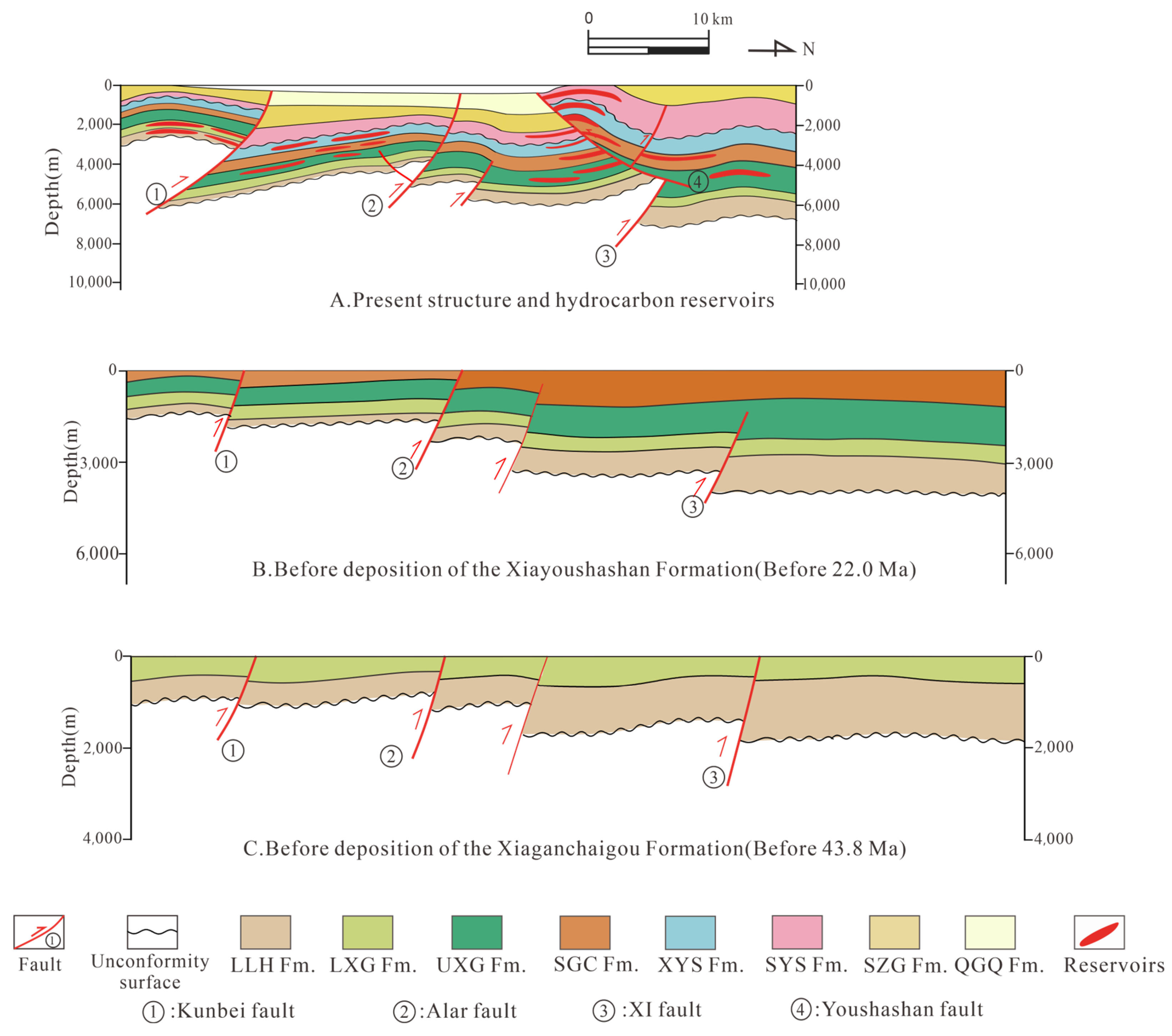


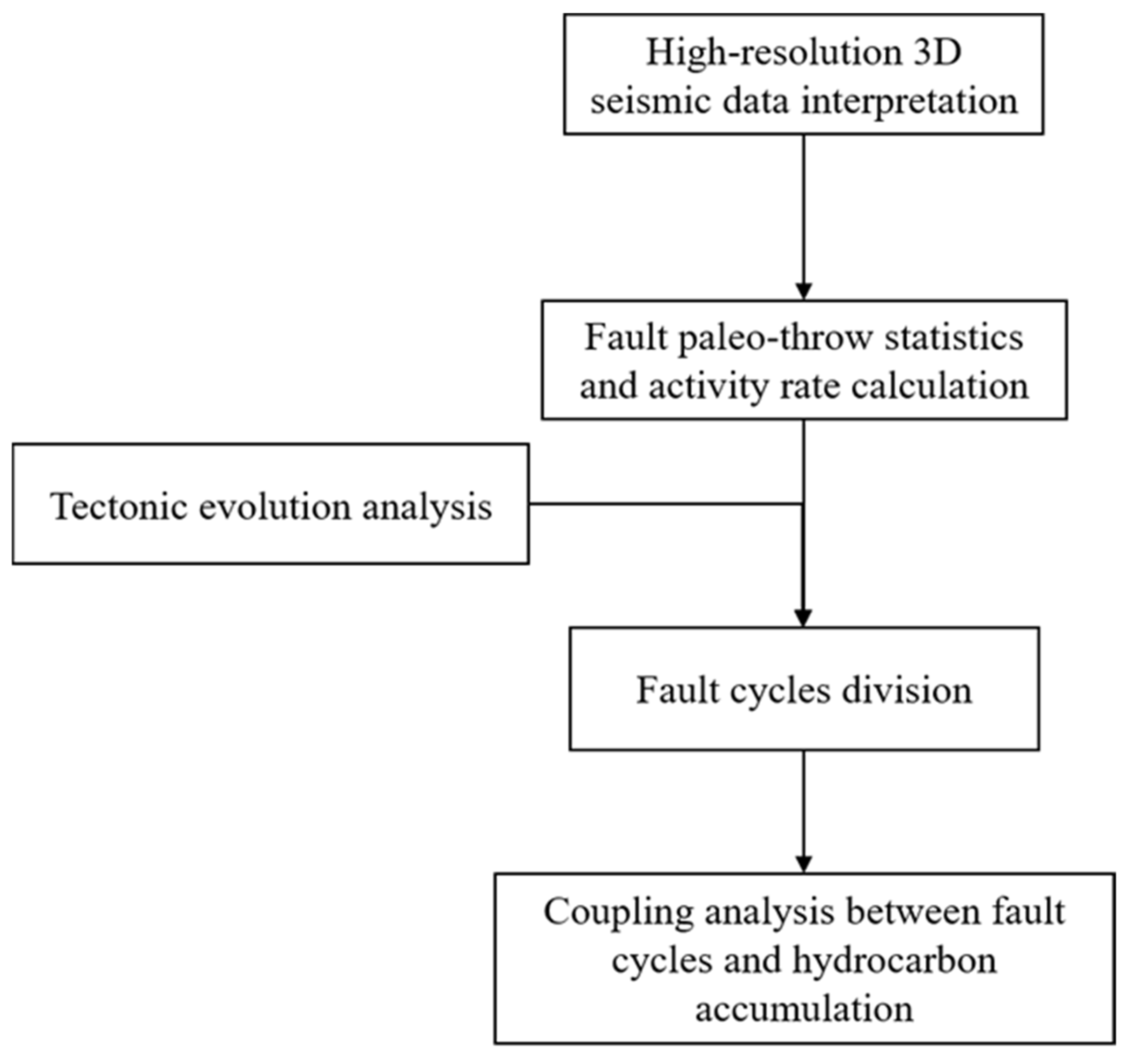
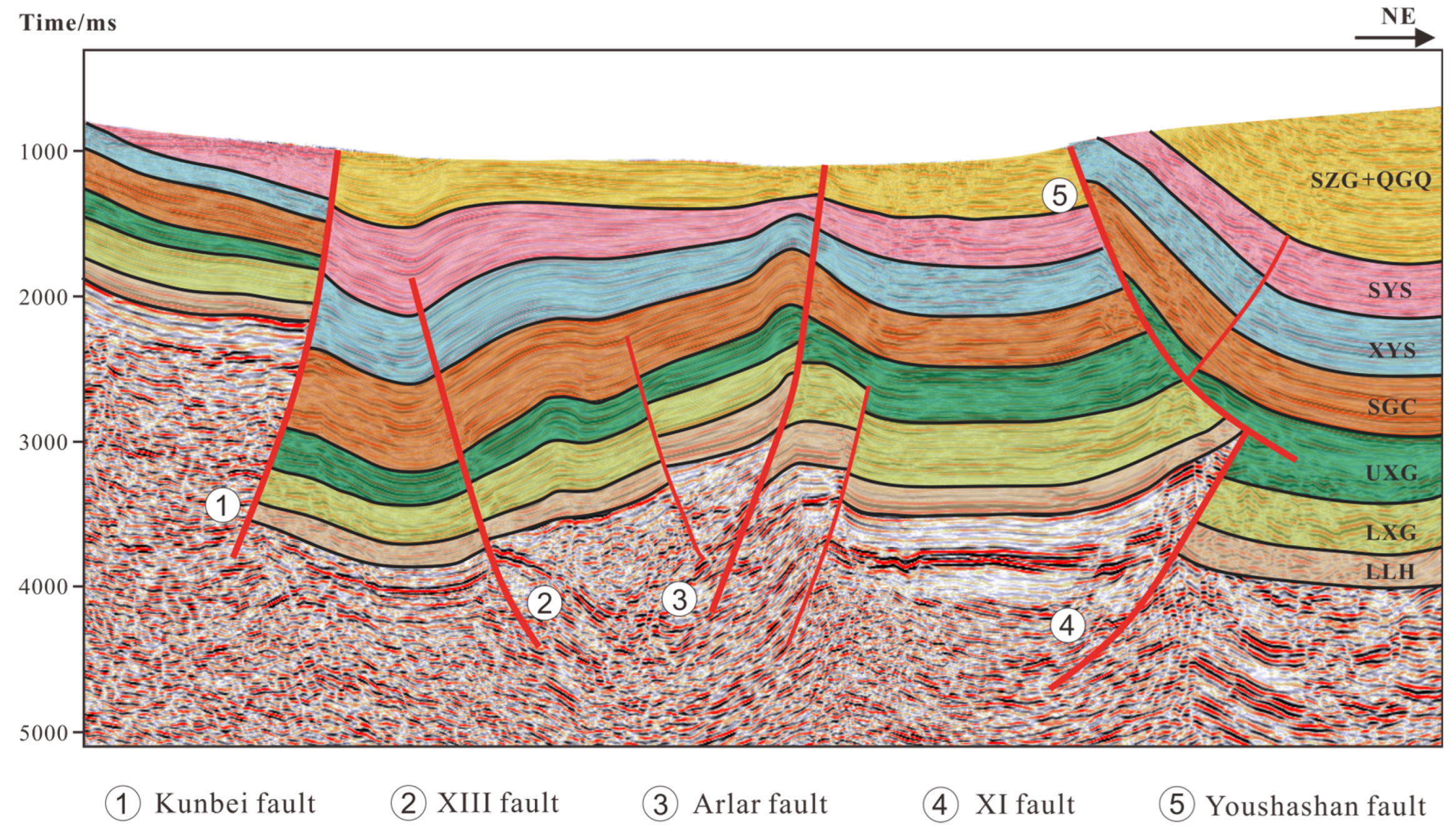

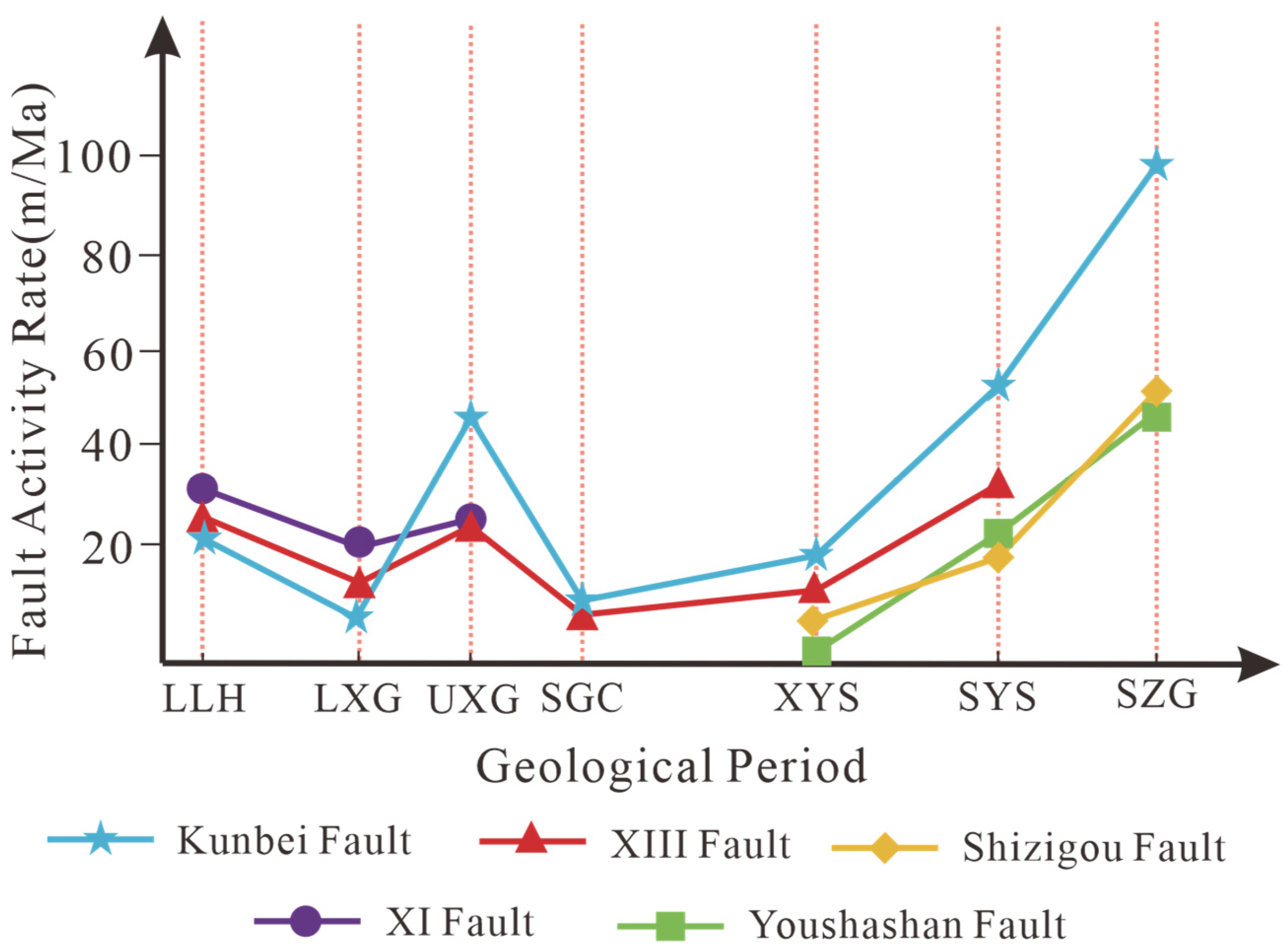

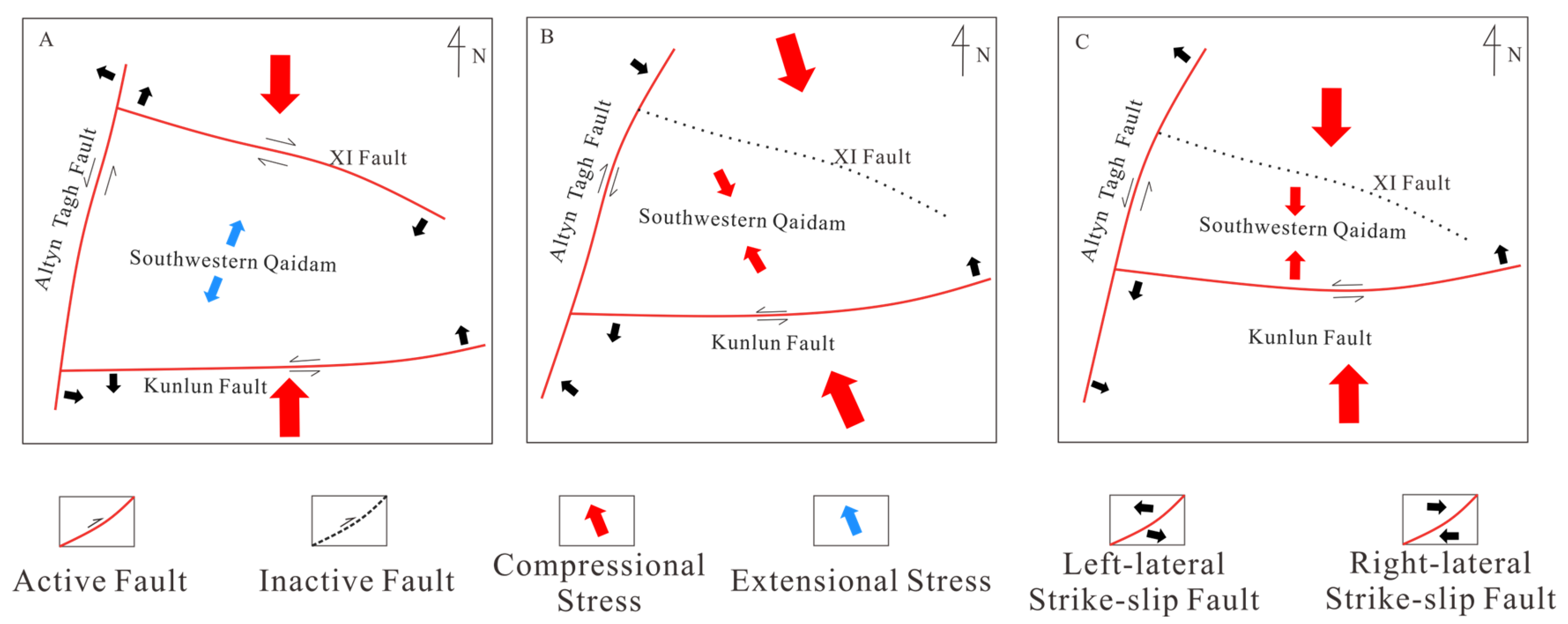
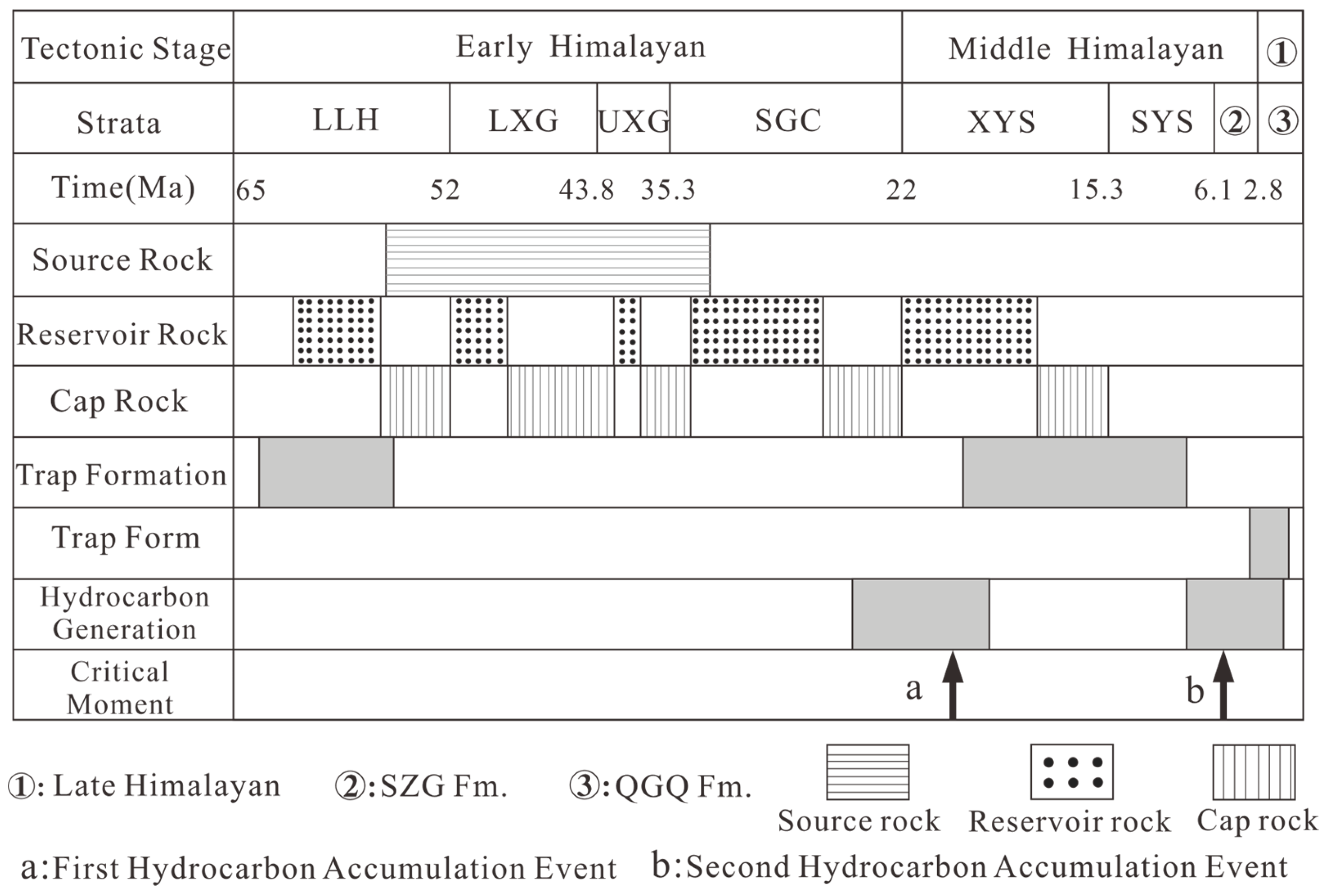

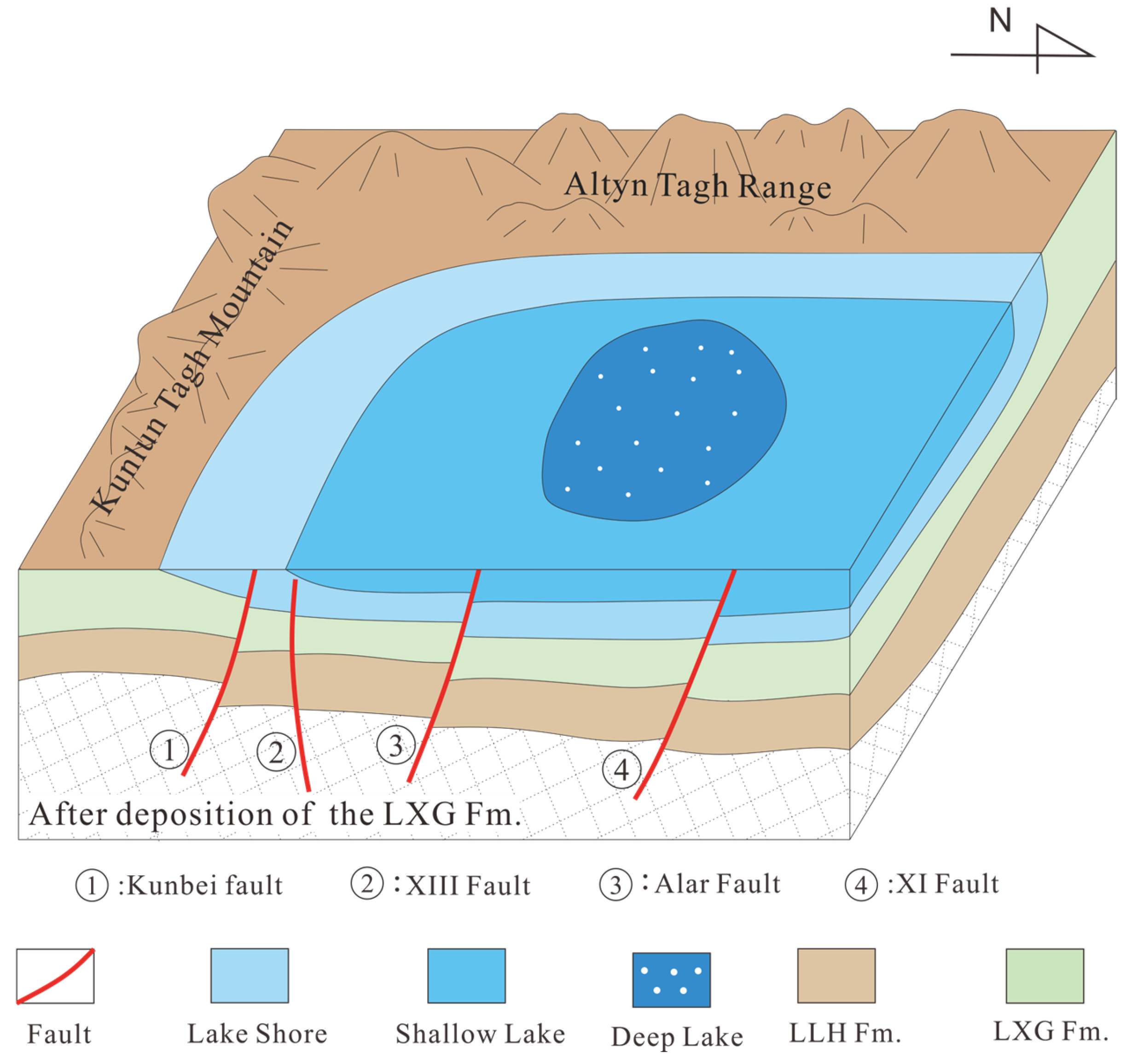
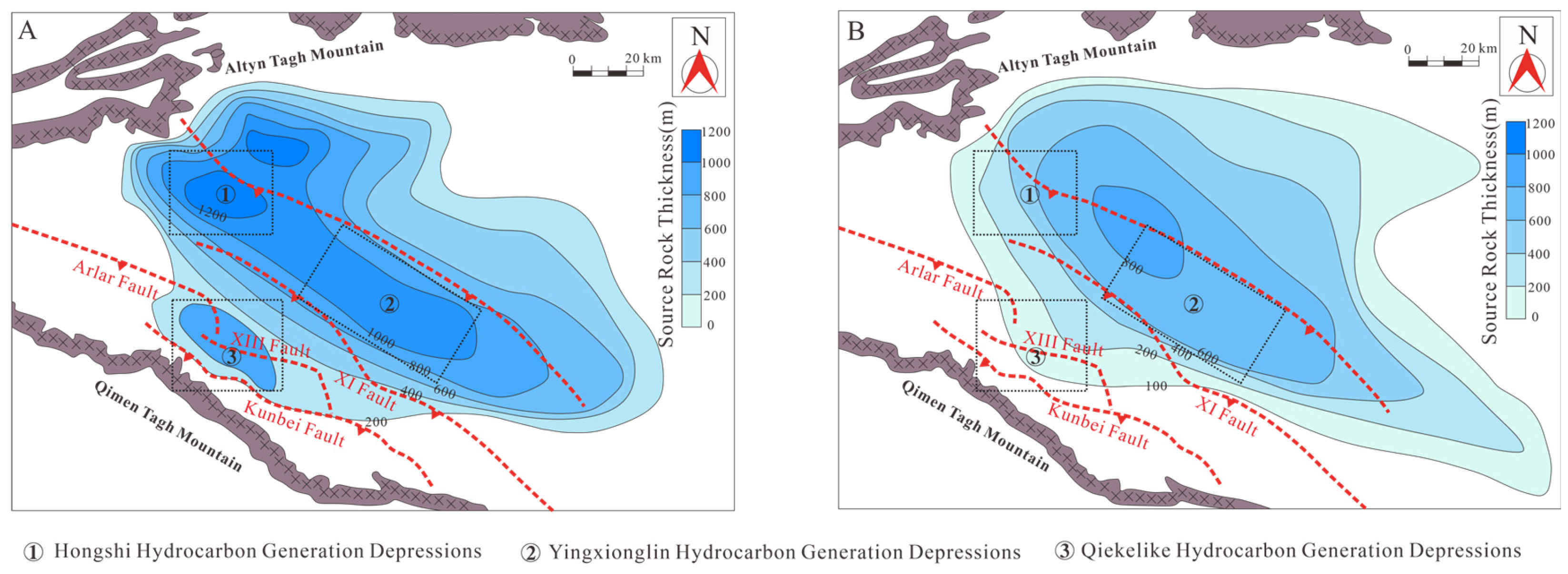



| Area | Eroded Strata | Range of Erosion Depth (m) |
|---|---|---|
| Kunbei | SYS~QGQ | 1500~2200 |
| Zhahaquan | SZG~QGQ | 0~500 |
| Yingxi | SYS~QGQ | 1500~1800 |
| Yingdong | SYS~QGQ | 1500~1700 |
| Fault Name | Strike | Dip (°) | Fault Properties | Length (km) | Faulted Horizon | Displacement (m) |
|---|---|---|---|---|---|---|
| KunBei | NWW | 40–80 | reverse | >100 | LLH-QGQ | >3000 |
| XI | NWW | 40–80 | reverse | >9 | LLH-LXG | >4500 |
| XIII | NWW | 60–85 | reverse | >46.5 | LLH-SYS | >2000 |
| Shizigou | NNW | 15–27 | reverse | >30 | SGC-SYS | >1300 |
| Youshashan | NW | 10–27 | reverse | >62 | SGC-SYS | >1200 |
| Fault | Kunbei Fault (m) | XIII Fault (m) | XI Fault (m) | Shizigou Fault (m) | Youshashan Fault (m) | |
|---|---|---|---|---|---|---|
| Strata | ||||||
| QGQ | - | - | - | - | - | |
| SZG | 518 | - | - | 265.2 | 256 | |
| SYS | 405 | 186 | - | 135 | 150 | |
| XYS | 147 | 100 | - | 73 | 41 | |
| SGC | 226 | 211 | - | - | - | |
| UXG | 374 | 181 | 212 | - | - | |
| LXG | 101 | 129 | 160 | - | - | |
| LLH | 275 | 307 | 408 | - | - | |
| Traps’ Name | Formation Period of Traps | Stabilization Period of Traps |
|---|---|---|
| Qigequan | LLH | QGQ |
| Yuejinyihao | LLH | SZG |
| Wunan | SGC | QGQ |
| Shizigou | XYS | SZG |
| Youshashan | XYS | SZG |
| Ganchaigou | XYS | SZG |
Disclaimer/Publisher’s Note: The statements, opinions and data contained in all publications are solely those of the individual author(s) and contributor(s) and not of MDPI and/or the editor(s). MDPI and/or the editor(s) disclaim responsibility for any injury to people or property resulting from any ideas, methods, instructions or products referred to in the content. |
© 2025 by the authors. Licensee MDPI, Basel, Switzerland. This article is an open access article distributed under the terms and conditions of the Creative Commons Attribution (CC BY) license (https://creativecommons.org/licenses/by/4.0/).
Share and Cite
Chen, Z.; Liu, Z.; Li, J.; Zhou, F.; Feng, Z.; Ma, X. Fault Cycling and Its Impact on Hydrocarbon Accumulation: Insights from the Neogene Southwestern Qaidam Basin. Energies 2025, 18, 3571. https://doi.org/10.3390/en18133571
Chen Z, Liu Z, Li J, Zhou F, Feng Z, Ma X. Fault Cycling and Its Impact on Hydrocarbon Accumulation: Insights from the Neogene Southwestern Qaidam Basin. Energies. 2025; 18(13):3571. https://doi.org/10.3390/en18133571
Chicago/Turabian StyleChen, Zhaozhou, Zhen Liu, Jun Li, Fei Zhou, Zihao Feng, and Xinruo Ma. 2025. "Fault Cycling and Its Impact on Hydrocarbon Accumulation: Insights from the Neogene Southwestern Qaidam Basin" Energies 18, no. 13: 3571. https://doi.org/10.3390/en18133571
APA StyleChen, Z., Liu, Z., Li, J., Zhou, F., Feng, Z., & Ma, X. (2025). Fault Cycling and Its Impact on Hydrocarbon Accumulation: Insights from the Neogene Southwestern Qaidam Basin. Energies, 18(13), 3571. https://doi.org/10.3390/en18133571






